Adam Yamey's Blog: YAMEY, page 104
December 14, 2022
Percussion on a ferry boat
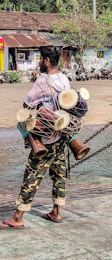
Laden with drums
He waits on the ferry boat
To cross the wide river
December 13, 2022
A tree and two shrines
WHILE TRAVELLING AROUND India, I have seen many trees that serve some kind of Hindu religious purpose. Often they are peepul trees, whose leaves are heart-shaped. Frequently, there is some kind of shrine next to the trunk, and often there are fine threads wrapped around the circumference of the trunk.
Near the middle of the market place in 8the Goan town of Mapusa, there is an old tree next to which there are two shrines. The tree’s leaves did not look like those of a peepul tree. What interested me was that at first sight both of the shrines, which resemble small huts, looked similar.
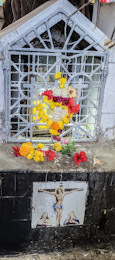
On closer examination, it could be seen that one of the shrines was, as I expected, Hindu, and the other was, to my surprise, Christian.
Whether this close proximity of the two shrines was pure coincidence or related to the fact that the tree provides good shade, I cannot say. Another possible explanation of the closeness might possibly be a symptom of inter-religious tolerance in this small Goan town. Who can say? Whatever the explanation for the closeness of the two shrines, it was heartening to see.
December 12, 2022
Baby Jesus with bangles
DURING SEVERAL TRIPS within the ex-Portuguese colony of Goa on the west coast of India, we have visited churches and other Christian religious establishments built under Portuguese rule. The Portuguese arrived in India several centuries ago, and finally left their colonies in 1961 when they became incorporated (or annexed) into India. One of the aims of the Portuguese was conversion of their Indian subjects to Christianity. Many of the conquered people became Christian, and many churches and seminaries sprung up in the occupied territories. We have visited quite a few of these.
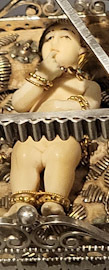
In most of the churches we have seen in Goa as well as in the recently opened Museum of Christian Art in Old Goa, we have noticed that depictions of angels saints, and Christ himself have facial (and other) features that are typical of Indian physiognomy. This is not too surprising as many artefacts in the churches of Goa were created by Indian artists.
When we visited the Museum of Christian Art in Old Goa, we saw two depictions of Baby Jesus lying on what looked just like typical Indian ‘charpoys’ (traditional Indian beds). The Holy Child in each case is a tiny doll. What fascinated me is that the dolls were wearing the sort of tiny bangles that are often worn by small Indian babies. One of the tiny models of Jesus was also wearing earrings.
Moving away from Christian sculptures and paintings, which have incorporated Indian characteristics, day to day Christian worship in India often incorporates features with origins in Hindu ritual practice. One example is the use of flower garlands (‘malas’), which is just as common in Christian settings as it is in Hindu settings.
Christianity was introduced to India not only by the Portuguese, but by others including St Thomas (apocryphally), and various European invaders. However, despite its foreign origins, India was not only affected by the Christian religion but has also made its mark on it.
December 11, 2022
A grand hotel in Goa
OUR FIRST VISIT to Goa was in about 2007. We stayed at a state run hotel in Colva, a seaside place in South Goa. It was August and the middle of the monsoon season. Much of the time, there was rain and frequently the beach was inaccessible because if the furious waves and wind dashing against it.
One day, we were driven to Panjim North of Colva, and stopped for lunch in the city’s tall Mandovi Hotel. The food served in its grandiose dining room was good. However, what impressed me most was that the hotel, which was built as a luxury establishment when the Portuguese ruled Goa, was a perfectly preserved and well maintained example of an old-fashioned inter-war European grand hotel.
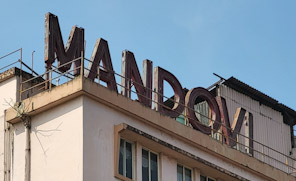
Because the hotel at Colva was, to put it mildly, very badly managed, we left it sooner than we had planned and spent a few days in the Mandovi. As far as I can recall, the hotel was both comfortable and well managed.
In 2018, we paid another visit to Panjim, and had a meal in its restaurant, which looked the same as it did in 2007. Sadly, the quality of the cooking and service had deteriorated.
The Mandovi Hotel was constructed on a plot that had belonged to a Noronha family. The seven storied building was ready to receive its first guests in December 1952, on the day that the Cardinal of Lisbon arrived in Goa. The hotel was where important Portuguese persons stayed. It was the best hotel in all of the territories ruled by Portugal. Stepping inside it was like taking a time trip back to the 1950s, if not before.
Behind the hotel, away from the riverfront, there is a domed Chapel attached to the hotel. This was built by the Noronhas family in 1827, and has been used ever since.
December 2022 found us back in Panjim. We walked over to the Mandovi Hotel and were horrified to find that its main entrance was padlocked closed and the place looked lifeless. A bystander told us that the hotel closed about 4 years ago because the two families who own it are fighting over it in a court of law.
I hope that the Mandovi Hotel will reopen and that it’s remarkable late Art Deco and Indo-Portuguese decorative features will be preserved. Even if it’s interior is modernised, which would be a pity, I hope that the terracotta coloured bas-reliefs on the hotel’s external wall will be saved.
December 10, 2022
A padlock with an unfortunate name
ABOUT 26 YEARS AGO, we had lunch in a state run hotel near the archaeological site at Hampi in Karnataka. On the way to a toilet, I had to pass some of the hotel’s bedrooms. Each was closed with a padlock. I do not know why I bothered to look at a lock carefully, but I am glad that I did. The lock was manufactured by the Hitler lock company. I could not believe my eyes, and I took a closeup photograph of it.
Since seeing that lock, I have visited India about 50 Times. On every visit, I have spent some time wandering around markets and bazaars in many Indian towns and cities. At every market I have kept an eye open for Hitler locks, but never found even one of them. When I have asked lock sellers if they stock them, the majority of them look blankly at me.

Today, the 9th of December 2023, we enjoyed a journey on a crowded local bus in Goa. We travelled from Panjim to the town of Mapusa to experience its large market. After wandering around for a few minutes, I noticed a small stall selling locks.
As I have always done at other markets I stopped to examine what locks were on sale. To my great surprise, the vendor had some Hitler padlocks. They were available in three sizes. I bought the middle sized version.
The locks are manufactured by Hitler Lock Enterprises,which is located in Aligarh in Uttar Pradesh State. I can only guess that the name Hitler was chosen because someone must have regarded him as being at least as strong as the locks they produce. Why they chose Hitler, rather than strong personalities such as Hanuman or Hercules, puzzles me.
After making my purchase and some others (mainly clothes), we ate superb seafood in the St Francis Xavier restaurant in the centre of the market. On our way back to the bus station (bus stand), we passed another lock seller. I noticed that he also had Hitler locks for sale.
Hitler is a brand name that would not sell well in most parts of the Western World. Judging by the fact that so far I have only found these locks in Mapusa, maybe it is not a trade name that goes down particularly well in India. However, Adolf’s book “Mein Kampf” is available in most Indian bookshops. Although its author was fixated on Aryans, he did not have a soft spot for Indians, as you will discover in the book “Hitler and India”, recently written by Vaibhav Purandare.
December 9, 2022
Some eagles in Old Goa
THE MUSEUM OF Christian Art has been recently been upgraded and is now a truly excellent display of Christian religious artefacts. It is housed in part of the convent of Santa Monica on Holy Hill in Old Goa. The convent Church was built in the early 17th century.
On arrival at the outside (south side) of the church, I spotted a bas-relief carved in stone above the main entrance to the church. It depicts an example of a heraldic creature that has long fascinated me: a double-headed eagle.
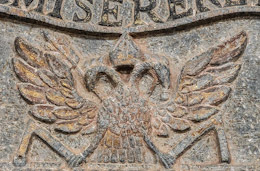
Inside the church, we met Natasha, who is the curator of the museum. I asked her if she knew about the reason for the double-headed eagle on the church. She informed us that the convent had been an Augustinian establishment, and that the double-headed eagle is a symbol used by that Order. That was news to me. She also directed me to another depiction of this creature on a carved tablet set into the church’s north wall.
When I returned to our lodging in Panjim, I consulted the internet, and learned about the connection between the Augustinian Order and the bird with two heads. It appears that although the main emblem of the Augustinians was a heart pierced with two arrow, the Hapsburgs allowed this Order to use their emblem, the double-headed eagle.
It will be recalled that there was a significant linkage of the Habsburgs and Spain. And Spain ruled Portugal between about 1580 and 1640. The Convent of Santa Monica was constructed between 1606 and 1627, and that was during the time that Portugal, which colonised Goa, was united with Spain. During that period, the united countries were ruled by Habsburg kings.
Although the museum, which I will describe later, was well worth the visit, discovering yet another example of the use of the double-headed eagle was a great thrill for me.
December 8, 2022
Cheese is nice … a true story
A POST ON FACEBOOK reminded me of something that happened about 27 years ago in a country east of France.

We were staying with a German lady, who used to become easily stressed. One day I was sitting in her living room whilst she was preparing a meal in the kitchen nearby. Something must have been going wrong because I heard her shouting “cheese is nice” in an angry voice. She repeated these words over and over again.
I like cheese, but could not understand why she was expressing a liking for cheese so angrily. And then the penny dropped. It dawned on me that she was not talking about cheese, but about Jesus Christ. In her perfect but Germanically pronounced English she was saying what sounded like “cheese is nice” but in reality she was cursing by saying “Cheesus Christ”
The posting on Facebook showed Joseph and Mary looking at Ababa doll in an opened Amazon delivery package. The caption to the picture was “Bloody hell, Alexa, I ordered baby cheeses”.
December 7, 2022
A refreshing breeze in Goa
I SHOULD NOT BE TELLING you about a wonderful place in the heart of Panjim in Goa, but I will.
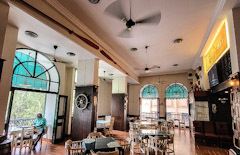
The Clube Vasco da Gama is situated on the first floor of a building beside Panjim’s lovely Municipal Garden. Founded in 1909, it occupied other buildings before it moved to its present site. With a pleasant decor, which evokes times long past, the Clube serves a wide range of drinks and superbly prepared Goan food. Today, we enjoyed baby squids stuffed with minced vegetable and chopped up squid, served in a tasty sauce. We also ate croquettes filled with a mildly spiced prawn purée. In addition, we consumed fried fish served in a very spicy sauce. Everything tasted wonderful, and as we will be in Panjim for several days, we will work our way through the menu.
We first came across the Clube in April 2018, when the weather was almost unbearable: extremely hot and humid. Quite by chance we came across the Clube and decided to enter it. We discovered that it has two small balconies, each overlooking the Gardens. Each of them has a small table with three chairs. All day long, there is a lovely, cooling breeze blowing across these two tables, making them the coolest places to sit in central Panjim (without resorting to finding places with air-conditioning).
It is because there are only two of these wonderfully positioned tables, it is with some trepidation that I am telling you about them. I do not want to turn up at the Clube to find them occupied by those who have just read this!
December 6, 2022
If it ain’t broke …
THE KAMAT GROUP has been operating hotels and restaurants for about forty years, if not longer. One of the branches is opposite the Jumma Masjid in the busy Commercial Street district of Bangalore (Bengaluru) in South India. I have visited this eatery many times during the 28 years that I have been making visits to Bangalore.
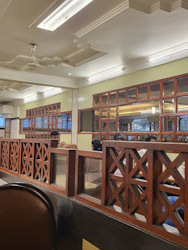
We usually drop in, or rather ascend the steps to, the seating area of Kamat’s to have a cup of coffee after doing errands in the crowded lanes that form the bustling area through which Commercial Street runs.
The interior of Kamat never changes. It has probably looked as it does today ever since it opened sometime before my fist visit to Bangalore. Its walls are simply decorated with mirrors and polished woodwork. A wooden barrier runs along the midline of the rectangular seating area, which comprises basic tables and chairs.
Despite not having the latest, trendy internal decor, Kamat in Commercial Street attracts many customers. The owners have done nothing noticeable to modernise the place; to make it compete with the many much more glitzy places in the city. Clearly, they understand the maxim ‘if it ain’t broke don’t fix it’
December 5, 2022
To beef or not to beef: a mistaken belief
AN INDIAN FRIEND came to the UK to work in the early 1960s. Shortly afterwards, his wife joined him. Back in those days before they became prosperous, one of their occasional treats was to eat in a Wimpy Bar.
My friend and his wife used to order hamburgers, which she enjoyed. Being a devout Hindu, she wanted to avoid eating beef. For years, she believed that the hamburgers were made from ham rather than any other meat. As she enjoyed these burgers so much, her husband decided not to reveal to her that the hamburgers were not made with ham, but with the meat her religion had taught her to avoid. Later, when she discovered that her hamburgers were made with beef, she did forgive her husband for, rather mischievously, concealing that information from her.
This true story, which I was told many years ago, came back to me when I saw a meat store in the grounds of the Bangalore Club (in Bangalore, India). Entertainingly called Meister Wurst, this place sells various prepared meats such as sausages, hams, and salamis. All are made to resemble products made in Germany, but they are manufactured in Bangalore.
There is a large coloured photograph in the front of the store. This image depicts a mouth-watering looking beefburger with the usual accompaniments, all contained between the two halves of a burger bun topped with sesame seeds. Above the photograph are two words, which would have pleased my beef avoiding, hamburger loving friend:
“Ham Burger”.

PS The name ‘hamburger’ has nothing to do with its ingredients. It comes from the name of the German city of Hamburg, where the dish might or might not have been ‘invented’.



